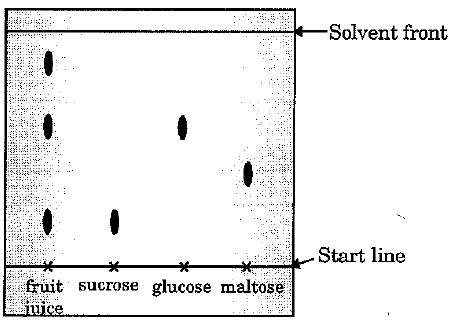
Answer
472.8k+ views
Hint: As the name suggests, a locating agent is a substance or chemical which helps to separate and analyze the colorless substances.
Complete step-by-step answer:
As we know the locating agent is a chemical that is used to visualize colorless by the naked eye or with the help of UV light.
The most widely used chemical reagent is Ninhydrin which reacts with the alpha-amino group of primary amino acids to form a complex called Ruhemann's purple.
It is also used for the detection of latent fingermarks on a porous surface like paper and cardboard.
In paper chromatography, the position of solvent front marked with the help of pencil and then chromatogram is allowed to dry. After that with the help of ninhydrin chemical reagent, the solution of ninhydrin is sprayed on the chromatogram which reacts with an amino acid to visualize purple-colored compounds.
From the above figure, we can conclude that fruit juice which is taken as Control is a mixture of sucrose, glucose, polysaccharides, fructose, etc.
Sucrose, glucose, and maltose have been taken as standards, and hence by the help of a locative agent which is used to separate and analyze the colorless compounds are visible.
So, in the above diagram, by using a locative agent we can conclude that sucrose and glucose are present in fruit juice while maltose is absent.
Note: Remember, two amino acids Proline and Hydroxy-proline do not react with ninhydrin chemical reagents in the same way as the other amino acids do because these two amino acids are having an alpha-amino group that is part of the five-membered ring.
Complete step-by-step answer:
As we know the locating agent is a chemical that is used to visualize colorless by the naked eye or with the help of UV light.
The most widely used chemical reagent is Ninhydrin which reacts with the alpha-amino group of primary amino acids to form a complex called Ruhemann's purple.
It is also used for the detection of latent fingermarks on a porous surface like paper and cardboard.
In paper chromatography, the position of solvent front marked with the help of pencil and then chromatogram is allowed to dry. After that with the help of ninhydrin chemical reagent, the solution of ninhydrin is sprayed on the chromatogram which reacts with an amino acid to visualize purple-colored compounds.
From the above figure, we can conclude that fruit juice which is taken as Control is a mixture of sucrose, glucose, polysaccharides, fructose, etc.
Sucrose, glucose, and maltose have been taken as standards, and hence by the help of a locative agent which is used to separate and analyze the colorless compounds are visible.
So, in the above diagram, by using a locative agent we can conclude that sucrose and glucose are present in fruit juice while maltose is absent.
Note: Remember, two amino acids Proline and Hydroxy-proline do not react with ninhydrin chemical reagents in the same way as the other amino acids do because these two amino acids are having an alpha-amino group that is part of the five-membered ring.
Recently Updated Pages
Who among the following was the religious guru of class 7 social science CBSE

what is the correct chronological order of the following class 10 social science CBSE

Which of the following was not the actual cause for class 10 social science CBSE

Which of the following statements is not correct A class 10 social science CBSE

Which of the following leaders was not present in the class 10 social science CBSE

Garampani Sanctuary is located at A Diphu Assam B Gangtok class 10 social science CBSE

Trending doubts
A rainbow has circular shape because A The earth is class 11 physics CBSE

Which are the Top 10 Largest Countries of the World?

How do you graph the function fx 4x class 9 maths CBSE

Fill the blanks with the suitable prepositions 1 The class 9 english CBSE

The Equation xxx + 2 is Satisfied when x is Equal to Class 10 Maths

Find the value of the expression given below sin 30circ class 11 maths CBSE

What is the length of the alimentary canal in human class 11 biology CBSE

Give 10 examples for herbs , shrubs , climbers , creepers

What is BLO What is the full form of BLO class 8 social science CBSE





